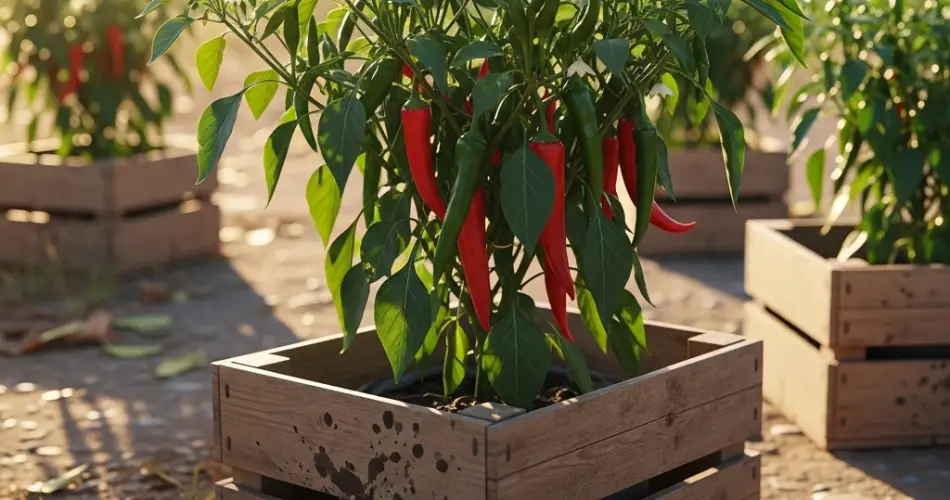Chili peppers are a versatile and flavorful addition to any home garden, offering a range of heat levels for culinary use, sauces, and preserves. For gardeners with limited space, growing chili peppers in crate planters is an effective solution. This approach maximizes vertical and horizontal space while providing ideal growing conditions for healthy plants and bountiful harvests.
Why Crate Planters Are Ideal for Chili Peppers
Chili peppers thrive when they receive consistent nutrition, proper drainage, and adequate sunlight. Crate planters provide several advantages for small-space chili production:
-
Space efficiency: Suitable for patios, balconies, and compact backyard areas.
-
Soil control: Allows creation of nutrient-rich, well-draining soil tailored for chili peppers.
-
Improved drainage: Reduces the risk of root rot and overwatering.
-
Ease of maintenance: Simplifies watering, fertilizing, and harvesting.
-
Pest management: Elevated crates limit contact with ground-dwelling pests and weeds.
Crate planters create a contained environment that encourages strong root development and healthy foliage, while also offering a rustic and attractive gardening solution.
Choosing the Right Crate Planter
The success of chili peppers depends on the crate’s size and structure. Consider the following when selecting a crate:
-
Depth: At least 12–16 inches to accommodate deep roots.
-
Material: Untreated wood is preferred to avoid chemical contamination.
-
Drainage: Drill holes in the bottom or use a slatted design lined with breathable landscape fabric.
-
Stability: Ensure the crate can support soil weight and growing plants.
Lining the crate with breathable fabric retains soil while allowing water to drain efficiently. Elevating the crate slightly improves airflow and protects the wood from moisture-related damage.
Selecting Chili Varieties
Choosing the right chili variety is crucial for success in crate planters. Consider size, growth habit, and heat preference:
-
Mild varieties: Such as bell or banana peppers, suitable for fresh eating and cooking.
-
Medium-heat varieties: Jalapeños or serranos are ideal for sauces and salsas.
-
Hot varieties: Habaneros, cayennes, or Thai chilies provide intense heat for enthusiasts.
-
Compact varieties: Perfect for small crates or limited-space gardening.
Taller or heavily fruiting varieties may require stakes or small cages to support upright growth.
Preparing Soil for Chili Planters
Chili peppers are heavy feeders that require fertile, well-draining soil:
Recommended soil mix:
-
40% high-quality potting soil
-
40% compost or aged manure for nutrients
-
20% perlite or coarse sand for drainage
Mix in a slow-release fertilizer before planting to provide consistent nutrients throughout the growing season. Foliar feeding with liquid fertilizer can further boost flowering and fruiting.
Planting Chili Peppers in Crates
-
Start seeds indoors 8–10 weeks before the last frost or purchase healthy seedlings.
-
Fill the crate with prepared soil, leaving 2–3 inches from the top.
-
Plant 1–2 chili seedlings per crate, ensuring adequate spacing to prevent overcrowding.
-
Water thoroughly to settle the soil around the roots.
Proper spacing ensures good airflow and reduces the risk of fungal infections or pest problems.
Sunlight and Watering Requirements
Chili peppers need warmth and consistent moisture for optimal growth:
-
Sunlight: Provide 6–8 hours of direct sunlight daily.
-
Watering: Keep soil evenly moist but not waterlogged. Water at the base of the plants to reduce disease risk.
-
Mulching: Apply straw or shredded leaves to retain soil moisture, moderate temperature, and suppress weeds.
Supporting Chili Plants
While many chili varieties are upright, taller or fruit-heavy plants may require support:
-
Use stakes or small cages to prevent bending or breaking.
-
Tie stems loosely as fruits develop.
-
Prune lightly to remove damaged leaves and improve airflow.
Support ensures healthy growth and simplifies harvesting.
Pest and Disease Management
Even in crates, regular monitoring is essential:
-
Aphids: Spray with water or neem oil.
-
Pepper worms: Remove by hand or use organic deterrents.
-
Fungal diseases: Ensure proper spacing, good airflow, and water at the soil level.
Frequent inspection keeps plants healthy and productive throughout the season.
Harvesting Chili Peppers
-
Harvest peppers when they reach the desired size and color.
-
Use scissors or pruners to avoid damaging stems.
-
Regular picking encourages continuous flowering and fruiting.
At the end of the season, remove spent plants, refresh the soil, and compost healthy plant material to prepare the crate for the next crop.
Final Thoughts
Crate planters provide an efficient, practical way to grow chili peppers in small spaces while maintaining control over soil, drainage, and plant health. With proper care, watering, sunlight, and regular fertilization, gardeners can enjoy fresh, flavorful chili peppers straight from their backyard. This method is both space-saving and rewarding, making it ideal for gardeners seeking maximum productivity in compact areas.



